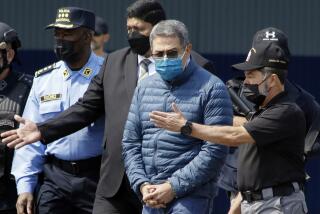U.N. report says cultivation of the plant used to make cocaine is surging in Colombia

Colombia saw a record level of coca plant cultivation last year, according to a United Nations report released Wednesday, raising renewed concerns about the war on drugs.
Reasons for the increased cultivation of the plant used to make cocaine include the suspension three years ago of an aerial herbicide spraying program and a lack of alternatives for poor farmers, authorities said.
Colombian President Ivan Duque, who took office last month, has called coca production a national security risk and faces challenges to placate the United States, a staunch ally that has spent billions of dollars in anti-drug aid in the country. President Trump has warned that he may consider Colombia uncooperative in the drug war.
Enough coca plants were grown in 2017 to produce 1,379 metric tons of cocaine, up 31% from the 2016 harvest, said Bo Mathiasen, representative of the U.N.’s Office on Drugs and Crime in Colombia.
“This is the highest figure since the United Nations began monitoring coca crops in Colombia” in 1999, Mathiasen told reporters in Bogota, the capital.
Perceived impunity among farmers in remote coca-growing areas has opened the way for entry of more fertilizers and other agricultural aids, pushing up yields, he said. Drug gangs in remote lawless areas often give farmers no choice but to grow coca, he said.
Michael Shifter, president of the Inter-American Dialogue, a policy think tank in Washington, said he was “not surprised but still shocked” by the result in light of the $10 billion in anti-drug and counter-terrorism aid the U.S. has given to Colombia since 2000. Policies including crop substitution and forced eradication have not yet yielded sustainable results, he said.
“The best anti-drug policy is building strong governmental institutions in areas where coca is grown and in focusing on rural development,” Shifter said. “To date, however, there has been scant if any progress on those fronts.”
Satellite imagery and on-the-ground monitors show Colombian farmers were growing 422,550 acres of coca on Dec. 31, or 17% more than the 360,773 acres detected the previous year, which was a record crop.
The increase in the coca farming dates from 2015 when then-President Juan Manuel Santos halted U.S.-financed aerial spraying of the herbicide glyphosate because of concerns that it causes cancer.
Santos also reduced manual eradication of coca in a bid to smooth over peace negotiations with the Revolutionary Armed Forces of Colombia, or FARC, which admitted to engaging in drug trafficking before signing a peace deal in late 2016.
Mathiasen said the increase in coca crops also has much to do with the lack of economic alternatives for 119,000 farm families estimated to be growing the illicit crop, and he urged international assistance to help Colombia bear the high cost of such alternatives. The U.N. has long held that crop substitution is the only effective method of combating coca farming.
Many farmers are being forced by drug gangs to stick to coca, and those who opt out to grow legal crops are risking their lives, Mathiasen said.
To illustrate his point, he said that 63% of the 288 social leaders killed over the last two years in Colombia were slain in townships where coca crops are present. Many victims were urging farmers to join crop substitution programs.
Adam Isacson, a senior fellow at the Washington Office on Latin America, said Duque is likely to come under increased U.S. pressure to achieve short-term reductions in coca production.
U.S. pressure could result in Colombia restarting aerial fumigation with glyphosate “at least in a limited way as part of a mix of strategies,” Isacson said. “The U.S. government is making it very clear to the Duque government that it is willing to restart the fumigation program,” although not on the scale during George W. Bush’s administration, when “a full-blown program” cost taxpayers $200 million a year.
Such a resumption of aerial spraying is opposed by Colombian human rights and environmental groups and could lead to social strife among the thousands of families who depend on coca for their livelihoods, he said.
A Colombian government program pushing voluntary eradication by coca farmers who got economic aid to grow legal crops has sputtered, Isacson said. Of the 125,000 acres of coca that the Colombian government promised to neutralize that way in 2017, only 17,000 acres were converted voluntarily, he said.
Duque is expected to prepare a new comprehensive anti-drug strategy to combat coca farming and reduce cocaine production.
Kraul is a special correspondent.
More to Read
Sign up for Essential California
The most important California stories and recommendations in your inbox every morning.
You may occasionally receive promotional content from the Los Angeles Times.










